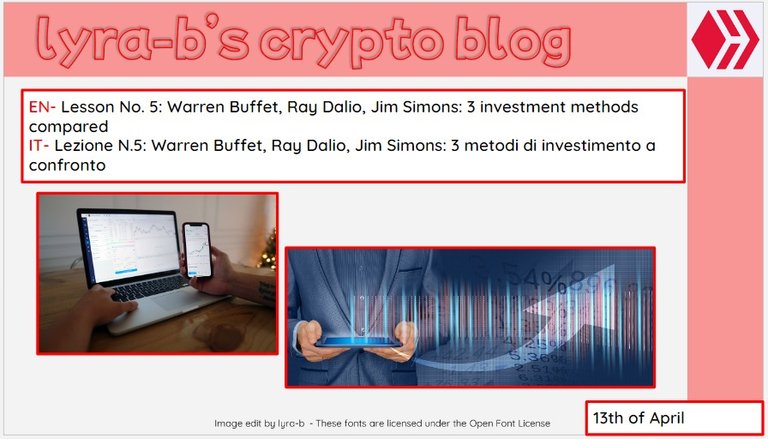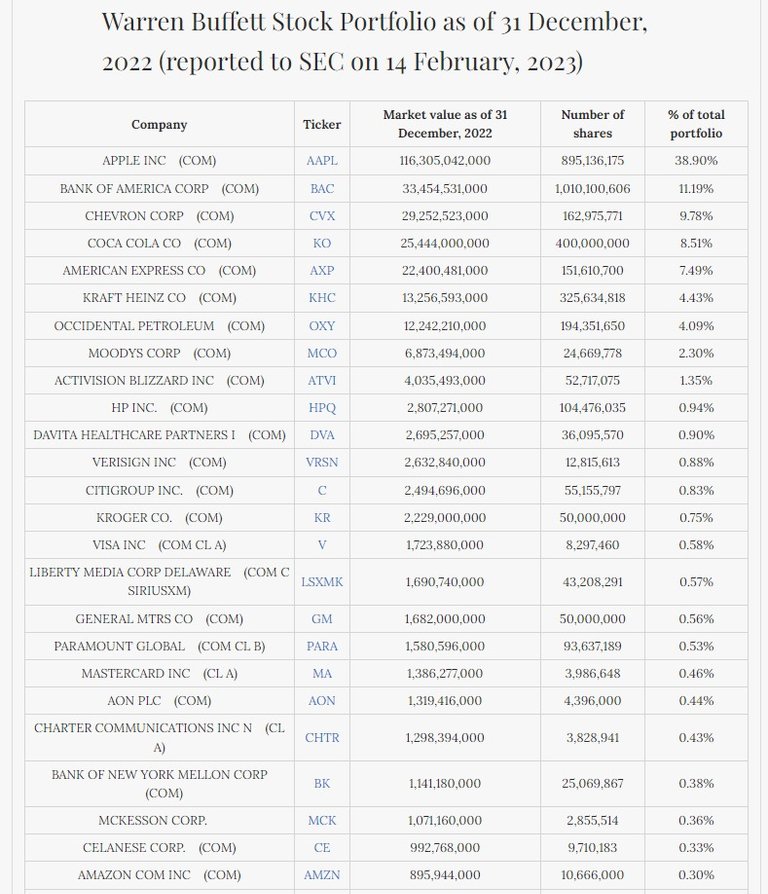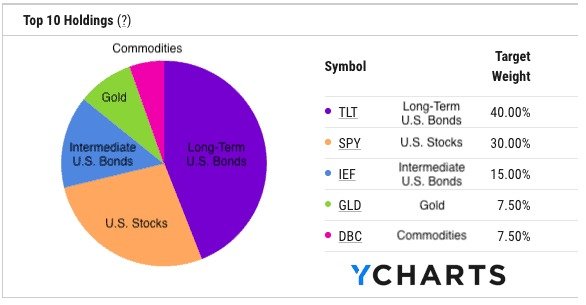
Hive logo source: https://hive.io/
Central image source:
Foto di Gerd Altmann da Pixabay ;
Foto di TheInvestorPost da Pixabay
English version
Introduction:
I want to share with you from LeoFinance some important insights I am getting about the world of economics and finance.
Disclaimer: I am not a financial advisor, so what is written in this post is a personal opinion, not financial advice. If you want to invest, you must do so knowingly and on your own responsibility.
Lesson No. 5
Below is a summary of the investment methods of three of the greatest investors of the last century:
-Warren Buffet
-Ray Dalio
-Jim Simons
WARREN BUFFET
He knows about companies and pretty much only buys stocks. He has earned an average of 20% per year over 65 years. For years when earnings were exceptional, there have been others with drastic declines. Buffet's method is used to invest in ETFs.
Buffet buys little and sells little, he studies a lot. Try to understand the real value of the company by calculating it.
-The characteristics of a company to invest in for Buffet are:
-the company must be established
-the company must have been on the stock exchange for many years
-the company must have a growing turnover for a number of years
-the company must have a growing CASH FLOW for a certain number of years
-the company must have an excellent management (evaluate both people and processes)
-high MOAT
-SECURITY MARGIN high
The company's CASH-FLOW is neither in the income statement nor in the balance sheet of the company, but it can be calculated. To explain it with an example, the cash flow of a shop is given by the following actions:
-everything I collect I put in the cash drawer
-everything I have to pay I take out
-what I have left at the end of the year is cash-flow.
In finance, cash flow is a very important indicator because it is from there that I understand whether I can pay the shareholders or not.
To explain MOAT with an image, it can be represented as the moat around the castle to prevent enemies from entering. The higher the moat, the safer the castle. Example Coca-cola, it has a very high MOAT.
The MARGIN OF SAFETY is that margin that, having made your assessments of intrinsic value and buying companies at a discount, I have to take into account a 20-30% margin of safety that reassures me of the mistake I might make by buying the shares of that company. It is better to buy a good company at a fair price than a fair company at a great price.
Warren Buffet's rules
-Rule #1 NEVER lose money
-Rule No.2 Never forget Rule No.1
-Be greedy when others are fearful and be fearful when others are greedy
-It is much better to buy a wonderful company at a fair price than a fair company at a wonderful price
-The financial market is a tool for transferring money from impatient people to patient people
-The price is what you pay, the value is what you get
-The best investment is in yourself. anything you can do to increase your knowledge and skills in the long run will be much more productive and effective than buying any kind of stock
-Risk comes from lack of knowledge
-If you are in a hole it is better to stop digging - when you don't know what is going on and what to do it is better to do nothing
-The most important quality of an investor is temperament, not intelligence.
-We should not be smarter than others but more disciplined than others
-You cannot make a good deal with a bad person

(source: https://www.buffett.online/en/portfolio/)
RAY DALIO
He knows markets and assets, his is an ALL SEASON portfolio. On average he has a gain of 7% per year and drops of 6-7%. He works with states, investment funds and multi-billionaires. His portfolio consists of 40% long-term bonds and 15% short-term bonds.
His is a balanced portfolio composed as follows
-long-term bonds
-short-term bond
-equities
-commodities (commodities listed on the stock exchange)
-gold

(source: https://ofdollarsanddata.com/ray-dalio-all-weather-portfolio/)
JIM SIMONS
He shows us that you can make money by knowing a lot about maths, being a trader is very similar to what Simons does. He saw market trends as equations to be solved as function studies. He uses massive amounts of data to come up with predictive mathematical models that have nothing to do with emotion.
His trading model is not replicable because his fund is private (65% return per year).
Question:
Which investment method do you prefer between Buffet, Dalio and Simons?
Versione italiana
Introduzione:
Voglio condividere con voi di LeoFinance alcune nozioni importanti che sto ricevendo riguardo al mondo dell'economia e della finanza.
Disclaimer: Non sono un consulente finanziario, quindi ciò che è scritto in questo post è un'opinione personale, non un consiglio finanziario. Se volete investire dovete farlo consapevolmente e sotto la vostra responsabilità.
Lezione nr.5
Di seguito un riepilogo dei metodi di investimento di tre dei più grandi investitori dell’ultimo secolo:
Warren Buffet
Ray Dalio
Jim Simons
WARREN BUFFET
Si intende di aziende e compra praticamente solo azioni. Ha guadagnato in media il 20% all’anno in 65 anni. Ad anni in cui i guadagni erano eccezionali, ce ne sono stati altri con dei cali drastici. Il metodo di buffet lo useremo per investire in ETF.
Buffet compra poco e vende poco, studia moltissimo. Cerca di capire il valore reale dell’azienda calcolandolo.
Le caratteristiche di un’azienda su cui investire per Buffet sono:
l’azienda deve essere consolidata
l’azienda deve essere da tanti anni in borsa
l’azienda deve avere un fatturato in crescita per un tot di anni
l’azienda deve avere un CASH FLOW in crescita per un tot di anni
l’azienda deve avere un ottimo management (valutare sia persone che processi)
MOAT alto
MARGINE DI SICUREZZA alto
Il CASH-FLOW aziendale, non è né nel conto economico nè nello stato patrimoniale dell’azienda, ma si può calcolare. Per spiegarlo con un esempio, il cash flow di un negozio, è dato dalle seguenti azioni:
-tutto quello che incasso lo metto nel cassetto dei soldi
-tutto quello che devo pagare lo tolgo
-quello che mi rimane a fine anno è il cash-flow.
Nella finanza il cash-flow è un indicatore importantissimo perchè è da lì che capisco se posso pagare gli azionisti o meno
Per spiegare con un’immagine il MOAT, è rappresentabile come il fossato che sta attorno al castello per non fare entrare i nemici. Più è alto il fossato, più il castello è al sicuro. Esempio Coca-cola, ha un MOAT molto alto.
Il MARGINE DI SICUREZZA è quel margine che, fatte le tue valutazioni sul valore intrinseco e sul comprare le aziende a sconto, devo tenere conto di un 20-30% di margine di sicurezza che mi rassicura sullo sbaglio che potrei compiere con l’acquisto delle azioni di tale azienda. E’ meglio comprare un’ottima azienda a un prezzo giusto che un'azienda giusta a un ottimo prezzo.
Le regole di Warren Buffet
Regola n.1 Non perdere MAI soldi
Regola n.2 Non dimenticare mai la regola N.1
Siate avidi quando gli altri sono paurosi e siate paurosi quando gli altri sono avidi
E’ molto meglio comprare una meravigliosa azienda a un prezzo giusto che un’azienda giusta a un prezzo meraviglioso
Il mercato finanziario è uno strumento per trasferire soldi dalle persone impazienti alle persone pazienti
Il prezzo è quello che paghi, il valore è quello che ottieni
Il miglior investimento è in te stesso. tutto quello che puoi fare per aumentare le tue conoscenze e abilità nel lungo tempo sarà molto più produttivo ed efficace che comprare qualsiasi tipo di azione
Il rischio deriva dalla mancanza di conoscenza
Se sei in un buco è meglio smettere di scavare - quando non si sa cosa succede e cosa fare è meglio non fare nulla
La qualità più importante di un investitore è il temperamento e non l’intelligenza.
Non dobbiamo essere più furbi degli altri ma più disciplinati degli altri
Non puoi fare un buon affare con una cattiva persona

(source: https://www.buffett.online/en/portfolio/)
RAY DALIO
Si intende di mercati e asset, il suo è un portafoglio ALL SEASON, per tutte le stagioni. In media ha un guadagno del 7% annuo e dei cali di 6-7%. Lavora con stati, fondi di investimento e multimiliardari. Nel suo portafoglio sono presenti il 40% di obbligazioni a lungo termine e il 15% di obbligazioni a breve termine.
Il suo è un portafoglio bilanciato così composto:
obbligazioni a lungo termine
obbligazione a breve termine
azioni
commodities (materie prime quotate in borsa)
oro

(source: https://ofdollarsanddata.com/ray-dalio-all-weather-portfolio/)
JIM SIMONS
Ci dimostra che si può guadagnare sapendo molto di matematica, fare il trader è molto simile a quello che fa Simons. Egli vedeva gli andamenti di mercato come delle equazioni da risolvere come studio di funzione. Utilizzo massiccio di dati per elaborare modelli matematici predittivi che non hanno nulla a che fare con l’emotività.
Il suo modello di trading non è replicabile perchè il suo fondo è privato (Rendimento del 65% all’anno).
Domanda:
Quale metodo di investimento preferite tra quello di Buffet, Dalio e Simons?
Thank you for this summary! As a fellow finance enthusiast, pieces like these go a long way in furthering my knowledge base. You are doing the Lord's work! I am sure I'm not the only one that found this useful. Keep it up! 👏👏
🍻
Thank you so much!! It is a pleasure for me to share the things I learn
Grazie Giulia, ottimo lavoro bravissima
Grazie a te!!
The rewards earned on this comment will go directly to the people sharing the post on Twitter as long as they are registered with @poshtoken. Sign up at https://hiveposh.com.
Meraviglioso! Questo post su questi tre investitori è un capolavoro. Tre tipologie di investimento completamente diverse, eppure tutte e tre molto efficaci.
Esatto 🙂 quella di Simons sarà impossibile da replicare, ma si potrebbe fare un mix tra Buffet e Dalio
Bello il mix Buffet e Dalio… andata, ci sto. Ormai l’hai detto, adesso facciamo un piano. !CTP